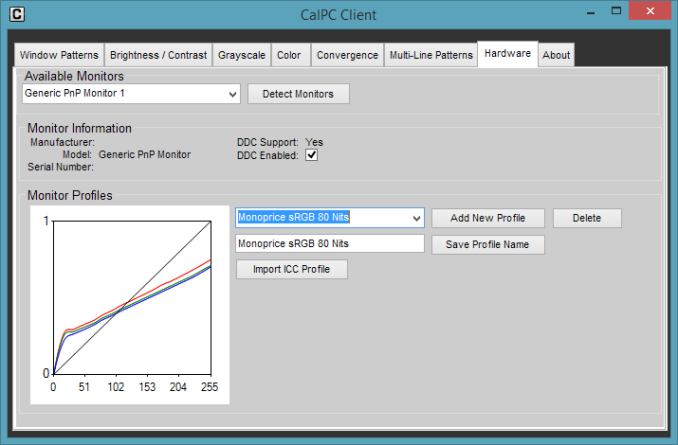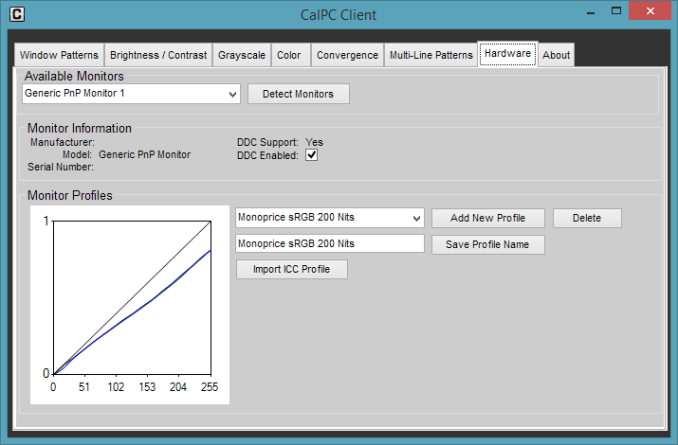Monoprice Zero-G Slim 27" IPS Monitor Review
by Chris Heinonen on August 26, 2013 12:00 AM ESTAll calibrations are done using CalMAN 5.1.2 software with an i1Pro meter and a C6 meter. Our targets are 200 cd/m^2 and gamma 2.2 for the pre-calibration and post-calibration measurements with the sRGB colorspace. We also try for 80 cd/m^2 and the sRGB gamma curve to see how well a display handles a more demanding professional setting.
| Pre-Calibration |
Post-Calibration, 200 cd/m^2 |
Post-Calibration, 80 cd/m^2 |
|
|---|---|---|---|
| White Level (cd/m^2) | 325.75 | 199.38 | 81.14 |
| Black Level (cd/m^2) | 0.373 | 0.335 | 0.322 |
| Contrast Ratio | 874:1 | 595:1 | 252:1 |
| Gamma (Average) | 1.309 | 2.195 | 3.051 |
| Color Temperature | 6744K | 6584K | 6648K |
| Grayscale dE2000 | 7.853 | 0.589 | 1.100 |
| Color Checker dE2000 | 7.611 | 0.942 | 1.000 |
| Saturations dE2000 | 5.413 | 1.083 | 0.995 |
Running the Zero-G at Contrast 50 and Brightness 50 with the sRGB preset, these are the best numbers I could obtain without a calibration. Since we are targeting 200 cd/m^2 and not 325 cd/m^2, that makes the numbers worse since we are expecting it to be 200 cd/m^2.
We see the gamma is incorrect and there are large grayscale errors. If I adjust the Brightness to 0 we see a gamma that is still wrong, and a blue color shift that gives us an average color temp of 8797K. The contrast ratio also falls to 580:1 and overall performance is worse.
If you only look at the Color Gamut chart, everything looks nice. Switch to the Saturations chart and you’ll see that the 40% red saturation target is past even where 60% should be. Blue and Magenta are over-saturated as well. The color checker chart confirms these saturation errors. This is why using only the standard gamut chart, as many people and print magazines do, provides little insight into actual performance.
Out of the box, the Monoprice Zero-G offers weird, strange performance that I haven’t seen in a long time. It also offers proof of why a panel in a monitor is only a small part of what leads to a quality display.
Calibrate the Monoprice and you have a totally different display. Look at the numbers and they are virtually perfect. If you are targeting 200 cd/m^2 you will have trouble doing better except with contrast ratio and black level. Those are still worse than what other monitors can produce.
Calibrate for 80 cd/m^2 and an sRGB target and you’ll see that performance isn’t quite as good as the 200 cd/m^2 target. The reason is the brightness control. Below are images from the CalPC client that CalMAN uses to calibrate. You can see the default line (in black) and the adjustments made to Red, Green and Blue channels for different output levels. Ideally these should track the default line.
On the Monoprice they start out much lower on the right. Because we have to correct for the brightness levels in the LUT, instead of using the display controls, we lose dynamic range and contrast ratio. The black level doesn’t change but the white level is dropping. We also don’t have as much room for adjustment for the gamma curve, which is why the sRGB one suffers.
CalMAN has corrected a lot of the flaws in the Monoprice compared to the default settings, but it has to take a large hit to contrast ratio to do so.






























79 Comments
View All Comments
blackoctagon - Tuesday, August 27, 2013 - link
Minor pedantic correction: lack of OSD and a scaler (plus the fact that there is only DVI as the sole supported input) keeps input lag and overall latency low, but the pixel response time of the S-IPS panel remains the same as before, i.e., "approximately 6ms or less (GTG)"Koblek - Tuesday, August 27, 2013 - link
Thanks for the correction blackoctagon:)blackoctagon - Tuesday, August 27, 2013 - link
In a recent BenQ review Chris claimed that he would review these if he could get his hands on a sample. At the time he seemed unaware of Overlord - he claimed that the only overclockable IPS screens were imports - so I hope he will eventually review these delightful monitors.That said, no I'm not aware of any 'official'/pro reviews, just lots of glowing user reports
Subyman - Monday, August 26, 2013 - link
I have a korean 27" and it is a solid monitor. I also have a Viewsonic VP2770LED and it blows the korean monitor away in terms of quality and image. The step up from a typical TN to the korean is enormous, but so is the jump from the Korean to a fully featured high end monitor. Something that is very important for some people is the PWM dimming. I had major issues with head aches using the Korean monitor daily, while the Viewsonic has been pain free.atx9307 - Monday, August 26, 2013 - link
If anyone is looking to make a purchase at Monoprice now through 9/15, use code EMP1166 to get the lowest pricing listed on the site :)borderdeal - Monday, August 26, 2013 - link
I bought a X-Star monitor from ebay. I also got a Eye-one Display 2 calibrator for $35 shipped from ebay. I upgraded from a 27" 1920*1200 TN monitor. The X-star is way way better in color and viewing angels as expected. But calibrating the monitors made a big difference in both monitors. Even in the TN panel that I was amazed and regret not buying the Eye-one Display 2 before.cheinonen - Tuesday, August 27, 2013 - link
FYI (and for everyone else), the i1Display2 hasn't been made for a few years now. It has a non-sealed optics design that is especially prone to drift. I compared mine (kept in a sealed bag with silica) to a NIST-certified i1Pro the other year and the i1Display2 had an average dE2000 error of close to 10.0. They can measure light output fine, but getting color accuracy from them after more than a year or two just doesn't happen due to the design.Impulses - Tuesday, August 27, 2013 - link
Any recommendations for a decent calibrator on a budget?borderdeal - Tuesday, August 27, 2013 - link
I think he is talking about this one but it is not cheap:http://www.amazon.com/X-Rite-EODIS3-i1Display-Pro/...
blackoctagon - Tuesday, August 27, 2013 - link
Spyder4Express?